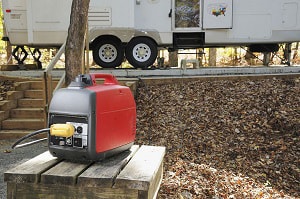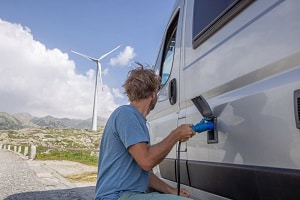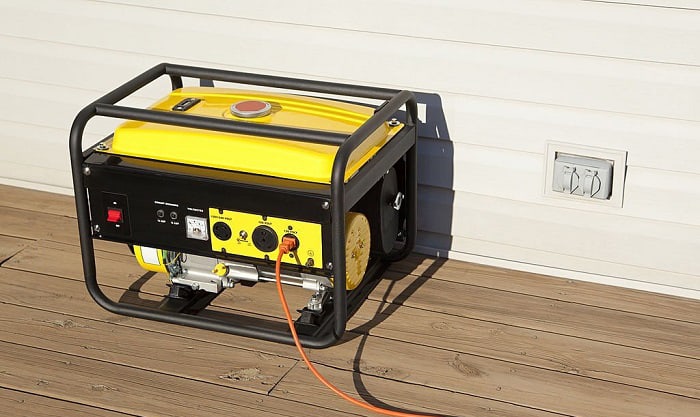Going camping is a fun and exciting activity. But the fun is gone when you lose the power connection.
If you are solely staying in an established campground, your power connection is safe since you will have access to electricity. However, if you want to go dry camping or to an area off the grid with a restricted supply of electricity, it is necessary to have a generator to charge RV battery.
A generator stores up and provides power to your appliances. It can be bought separately or built-in on your motor pool.
Now, let us discover step-by-step tips on how to charge an RV battery with generator.
Page Contents
Simple Steps to Charge Battery Generator
What to Prepare
- RV battery
- Generator
- Wire brush or any tool to clean the battery’s terminal points
Step-by-Step Instructions
An RV generator can be built-in or not. If your RV does not have one, it is best to know the total watts your appliances need in order to know what size generator to choose. Its powers typically range from 1000 to 4000 watts.
Therefore, be sure to pick an RV generator that can power all of your equipment.
To keep them functional in your boondocking, you must charge travel trailer battery. Here’s how to do it.
Step 1: Start the Generator
Make sure to bring the camper battery to a well-ventilated, flat surface. A good set-up will keep you safe and give you fresh air. Then, before starting it, remove all appliances plugged into it to charge the battery faster.
Depending on the generator type, you have two alternatives for starting it after removing the appliances.
- If the generator has a recoil starter, you can start it by drawing the rope outward.
- Turn the key clockwise to start a generator that has a key starter.
Once the generator has started, you should push the choke in or slide the rod from left to right to remove it from its resting position.
Step 2: Warm-up the Generator
After the generator has started, wait a few minutes before connecting it to your appliances using the Honda generator or any other RV generator you may have. Then, make sure that the generators’ voltage stabilizes. The cords might then securely fasten to the battery in this manner.
Step 3: Attach the Battery Charger
Using the alligator clips, attach the battery charger to the battery terminal. Make sure the appropriate clips are secured to the terminals.
For instance, you must connect the red alligator clip to the battery’s positive terminal, which is the plus symbol (+). Fasten the black alligator clip to the battery’s negative terminal, shown by the negative sign (-).
Step 4: Plug-in the RV Power Cord
The fourth step in charging RV battery with generator is to connect the generator firmly to the battery. Next, turn on the power outlet for the generator.
Before leaving it, you should check if the battery charger is operating by inspecting its indicator light.
If the battery is 20 to 30 percent, you should charge it with a generator for roughly 8 to 10 hours. To fully charge the battery that is almost full, however, you only need a few hours.
Step 5: Turn Off the Charger
After a few hours of charging the RV battery, the charger must be turned off and disconnected from the generator. Some chargers automatically turn off when charged, while some do not. To ensure safety, always unplug the connection after charging the battery.
To disconnect the cable, you must take the following actions:
- First, remove the black alligator clip attached to the negative (-) terminal.
- After that, you can remove the red alligator clip from the positive (+) terminal.
Important Safety Precautions
- To better understand how to operate a generator, read the instructions thoroughly before using it. Majority of the time, instructions specify how long you should let the generator charge and how much electricity it can hold.
- Check to see if the cords you’ll be using are functional and not torn. To avoid dangers, replace any damaged cables and cords right away.
- Before charging the RV battery with the generator, unplug all cords and turn off your appliances so that the batteries will charge quickly.
- Before connecting the alligator clips to the terminals, clean the terminals using a wire brush and maintain them free of dust.
- Ensure that you are operating the generator outside the RV.
- Don’t forget to switch off the generator after charging the batteries.
Frequently Asked Questions
How long do I need to run a generator to charge my RV battery?
It all depends on how much percent is left in the batteries. If the battery is down to 20 to 30 percent, you will need 8 to 10 hours to complete it. If the battery isn’t used frequently and is nearly complete, two hours is enough to charge it completely.
It will generally take 10 to 12 hours for a deep cycle battery to fully charge. But don’t worry, you can still enjoy dry camping because the battery will last longer.
In addition, consider variables like generator output, the number of appliances you use, and the number of batteries the generator is charging. It goes without saying that using a generator to charge three lithium batteries simultaneously will result in a longer charge time.
Why won’t my generator charge my RV battery?
An RV battery not charging from generator might indicate issues that you need to check. It includes the following:
- Ensure that the generator isn’t too small to do the job. It should be big enough to store electricity for the batteries and your appliances.
- Check the cords and make sure that it is not damaged.
- Make sure that the cords are attached firmly to the battery terminals.
- Also, your generator must have enough fuel to run.
- If you still experience the RV generator not charging batteries, you must troubleshoot it with the help of a professional.
Does an RV generator charge house batteries?
Undoubtedly, properly using an RV generator to charge the house batteries is safe and beneficial. It can power any 120-volt item in your house in addition to charging the batteries.
Nonetheless, using an inverter generator charge my RV battery way better than ordinary generators. It is more efficient and consumes less fuel than the regular one. What you’ll like is it creates less noise.
What is the fastest way to charge RV batteries?
First, you must turn off all appliances before charging your RV battery. The following methods are the quickest to charge 12v battery:
- You can use a large-capacity generator which is efficient and risk-free.
- Using a converter will also charge your batteries faster.
- There is DC power, solar power, and wind power which you can use to charge a battery.
- And finally, it’s possible to recharge the batteries while driving. Only deep cycle batteries, which have a greater capacity for energy storage, can do this.
Conclusion
There are a lot of ways to charge an RV battery. However, employing generators is the most practical and economical option out of those available. However, the decision ultimately comes down to what is beneficial for you.
Doing the steps on how to charge an RV battery with generator will help you enjoy your boondocking without worrying about the sudden loss of your RV’s power. Now that your RV batteries are charged, you are good to go. Enjoy your vacation!
“Hi, I’m Francis’ husband—Calvin. Our story began with our shared passion for traveling. I have had a career journey for over 11 years at Ford Motor Company, where I took on the role of BMS SW Process Engineer.
Together with my wife, I have dedicated countless hours to exploring every nook and corner of the world. Ten years living in an RV may seem long, but time seems to fly by when I’m doing what I love with the person I love.
FMCA’s 103rd International Convention & RV Expo in Gillette, WY,
Like my wife, I hope to help you see the beauty of traveling off the beaten path by sharing insights into this lifestyle. In addition to my corporate roles, I also launched our website – Outdoorbits, in 2015 and continue to contribute my knowledge and skills to the present day. And I’ll be completely honest with you—no hiding the truth or sugarcoating the possible challenges.
So, if you want to run away from the busy lifestyle to embrace nature, I’m your guy.”








